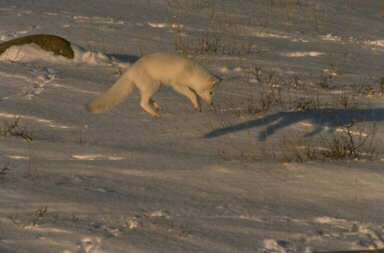
 |
| Arctic foxes pounce on their prey in the same manner red foxes do. |
The arctic fox can eat almost any form of meat readily available. Prey consists primarily of lemmings and voles, but can also include arctic ground squirrels, hares, seal pups, birds such as ptarmigan, eggs, fish, crustaceans, and mollusks. When hunting, a fox can hear prey hiding up to 1.5m below the ice, and is capable of clawing through this ice to get it. The fox can exploit any source of carrion, and its keen nose can detect a carcass from up to 50km away.
The arctic fox is an opportunistic scavenger. Packs of foxes regularly follow polar bears in the hopes of feeding off scraps from their kills. Like many other arctic creatures, foxes frequently have no fear of man, and human refuse can provide a feast to these animals. Fox populations can boom in the presence of human garbage dumps, increasing the possibility of disease.
Due to their smaller size and lower metabolism, arctic foxes can survive on less food than the red fox, allowing them to inhabit areas where their larger, southern cousins cannot. When food supply is not an issue, arctic foxes are normally displaced by the reds. Because it lives in areas where food is likely to be scarce, finding sustenance is a constant challenge for this species. Therefore, like many of its relatives, the arctic fox frequently caches excess food. Unlike the red fox however, the arctic fox prefers to larder hoard it´s food. Caches can be quite large, often enough to supply an individual for up to a month.
| Table of Contents |